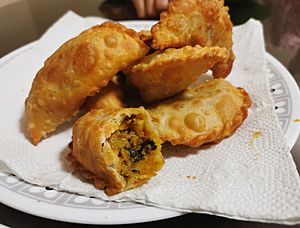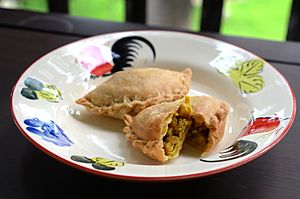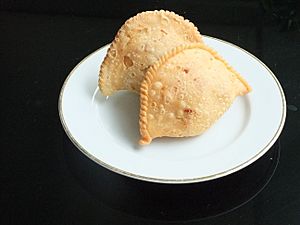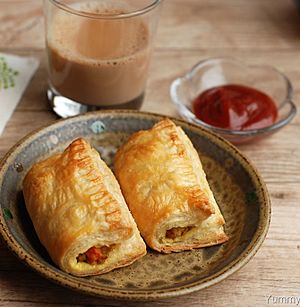Curry puff facts for kids

Curry puff from Malaysia
|
|
| Alternative names | Karipap, epok-epok, Pastel |
|---|---|
| Course | Entrée, side dish, snack |
| Region or state | Indonesia, Malaysia, India, Singapore |
| Associated national cuisine | Indonesia, Brunei, Malaysia, Myanmar, India, and Thailand |
| Serving temperature | Hot |
| Main ingredients | Curry, chicken, potatoes |
A curry puff is a delicious snack that comes from Southeast Asia. It's like a small, savory pie. Inside, you'll find a yummy curry filling, often with chicken and potatoes. The outside is a pastry shell that can be deep-fried or baked. The curry inside is usually thick so it doesn't spill out. The word "puff" in its name comes from a Chinese word that means "bubble" or "puffed up." This snack is a mix of different cultures, including Indian, Chinese, and Malay influences.
No one knows exactly where curry puffs first came from. But many believe they started in Southeast Asia. They might have been inspired by British Cornish pasties, Portuguese empanadas, and Indian samosas. These were popular during the time when European countries had colonies in Asia. Curry puffs are now the most common type of "puff" pastry. But you can also find other kinds with fillings like eggs, sardines, or sweet yam.
Curry puffs are enjoyed in many places across Southeast Asia and India.
Contents
Curry Puffs Around the World
Indonesia's Pastel
In Indonesia, a curry puff is called a pastel. Interestingly, these pastel snacks don't always have curry powder in them. They are still a very popular snack.
Malaysia's Karipap and Epok-Epok
In Malaysia, curry puffs are widely known as karipap. You can find them freshly fried at many food stalls. They are sold by Malay, Chinese, and Indian vendors. Even trendy cafes offer them.
Another Malaysian version is called epok-epok or teh-teh. These are usually smaller than regular curry puffs. Indian bakeries make curry puffs with a special "layered" pastry. This makes the crust extra flaky. Some epok-epok have half a boiled egg inside instead of chicken. Others might be filled with tinned sardines. There are also vegetarian curry puffs. These are not spicy and contain shredded radish, tofu, potatoes, and carrots. People often eat them with sweet chili sauce.
Some companies now make frozen curry puffs. You can buy these and reheat them at home. This makes it easy to send them to other countries, like the Middle East. New fillings are also being tried, such as tuna and black pepper.
India's Vegetarian Puffs
In India, bakeries often sell vegetarian curry puffs. These are filled with vegetables like potatoes, carrots, and onions. You can also find egg puffs and chicken puffs in Indian bakeries.
Myanmar's Be Tha Mont
In Myanmar, curry puffs are a common snack. They are sold in Chinatowns and tea shops. Here, they are known as be tha mont, which means "duck meat pastry." The traditional filling is duck meat and potato. It's spiced with garam masala, onions, chili powder, garlic, and ginger.
Singapore's Diverse Puffs
In Singapore, you can find curry puffs at night markets (pasar malams), bakeries, and food stalls. The epok-epok is also popular in some of Singapore's hawker centers. These are usually sold by Malay stalls. The more common type of curry puff in Singapore has a thick or flaky crust. Its filling often mixes Chinese and Indian styles.
Curry puffs can be handmade or made by machines. Handmade ones are often half-moon shaped. Machine-made ones can be triangular or half-wrapped circles. Both are popular, but some people think handmade ones taste better. Different colored marks on the side of the puffs can show what filling they have.
Many new puff flavors have been created. These include fillings like yam, durian, corn, red bean, nata de coco, grass jelly, and even custard. Besides these unique flavors, common ones like sardine, black-pepper chicken, and tuna are also very popular.
Old Chang Kee is a famous company in Singapore. They have been selling curry puffs for over 60 years. They now have stores in Singapore, Malaysia, Indonesia, Australia, and the UK.
Thailand's Karipap

In Thailand, a curry puff is called a karipap. It is believed that this snack came to Thailand from Portuguese cuisine. It arrived during the time of King Narai (1633–1688). A Portuguese-Japanese-Bengali lady named Maria Guyomar de Pinha might have introduced it. She also brought many other Thai desserts like thong yip and foi thong. Karipap is very popular in places like Amphoe Muak Lek and Saraburi province. In these areas, you can even find karipap with durian filling!
What's Inside a Curry Puff?
Curry puffs are usually filled with a mix of tasty ingredients.
- Curry powder gives them their spicy flavor.
- Potatoes are a common and filling ingredient.
- A small piece of hard-boiled egg is often added.
- Meat, usually beef or chicken, makes them hearty.
- Onions add extra flavor.
- The outside is made of Puff pastry.
- Sometimes, sardines are used as a filling.



